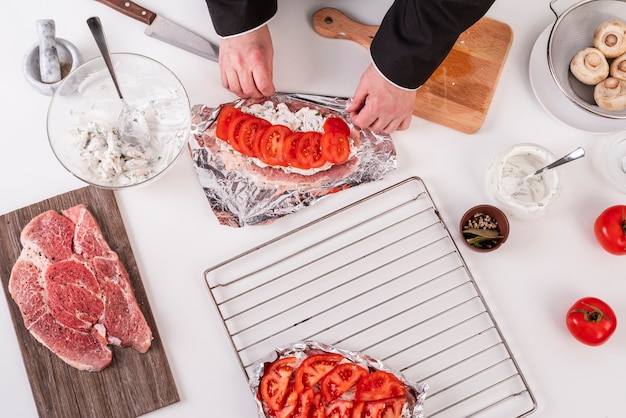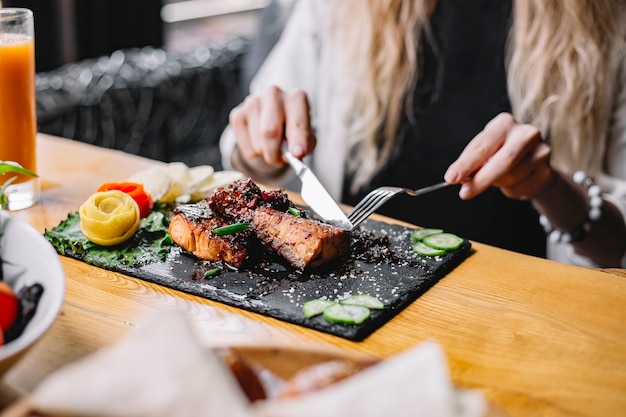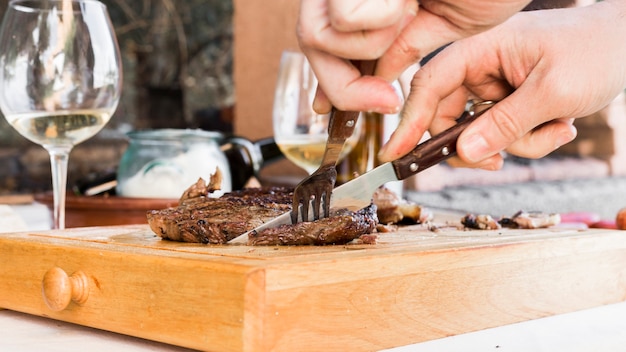Ah, prime rib. Just the name conjures up images of a glorious, glistening roast, the centrepiece of a celebratory meal. It's a dish that demands respect, a cut of beef that deserves to be treated with care. But let's be honest, cooking a prime rib can be a tad daunting. It's not just about chucking it in the oven and hoping for the best. There's a whole science behind achieving that perfect balance of juicy, tender, and flavourful.
And that, my friends, is where the cooking time per pound comes in. It's the key to unlocking the secrets of a truly delicious prime rib. You want to make sure it's cooked just right, not overdone and dry, but also not undercooked and raw. So, let's dive into the details, together, and demystify this culinary masterpiece.
(Part 1) Understanding Prime Rib and Cooking Times

What is Prime Rib?
Prime rib, also known as a standing rib roast, is a cut of beef taken from the rib section of a cow. It's known for its rich, beefy flavour, its impressive marbling (those lovely streaks of fat), and its tender texture. It's a cut that can be roasted whole, bone-in or bone-out, or even sliced into individual rib steaks.
The Prime Rib's "Sweet Spot": Why Cooking Time Matters
Cooking time is everything when it comes to prime rib. Why? Because it determines the level of doneness, which ultimately dictates the texture and flavour of your final masterpiece. Imagine biting into a dry, overcooked piece of prime rib - a culinary tragedy! No, we want that perfect balance of tender, juicy, and flavourful. It's about achieving that "sweet spot" of doneness, and that takes precise cooking.
Factors Affecting Cooking Time: It's Not Just About the Clock
It's important to understand that cooking time isn't a one-size-fits-all formula. There are a few key factors that come into play, and we need to consider them carefully:
- Size: The size of your prime rib plays a crucial role. A larger roast will take longer to cook through than a smaller one. It's all about heat penetration.
- Temperature: The oven temperature is a key player in this game. Higher temperatures cook faster, but can also lead to dryness. Lower temperatures allow for a more even and tender cook. It's a balancing act, and finding the right temperature for your roast is key.
- Oven: Yes, even the oven itself can have an impact on cooking time. Some ovens run hotter or colder than others. So, it's always a good idea to use a reliable oven thermometer to ensure accuracy.
- Desired Doneness: And of course, what about your preference? Do you love a rare prime rib, a medium-rare delight, or a medium cooked to perfection? This is crucial in determining the cooking time.
(Part 2) The Ultimate prime rib cooking time Chart

Now, let's get to the heart of the matter, shall we? It's time to tackle those cooking times. Don't worry, I've got you covered with a handy chart to help you navigate this process. Remember, these are just guidelines. Always check your prime rib's temperature with a meat thermometer to ensure it's cooked to your liking.
Cooking Time Chart: Your Guide to Prime Rib Perfection
| Roast Size (lbs) | Rare (125-130°F) | Medium-Rare (130-135°F) | Medium (135-140°F) | Medium-Well (140-145°F) | Well-Done (145°F ) |
|---|---|---|---|---|---|
| 3-4 lbs | 1 1/2-2 hours | 1 3/4-2 1/4 hours | 2-2 1/2 hours | 2 1/4-2 3/4 hours | 2 1/2-3 hours |
| 5-6 lbs | 2-2 1/2 hours | 2 1/4-2 3/4 hours | 2 1/2-3 hours | 2 3/4-3 1/2 hours | 3-3 1/2 hours |
| 7-8 lbs | 2 1/2-3 hours | 2 3/4-3 1/2 hours | 3-3 1/2 hours | 3 1/2-4 hours | 4-4 1/2 hours |
| 9-10 lbs | 3-3 1/2 hours | 3 1/2-4 hours | 4-4 1/2 hours | 4 1/2-5 hours | 5-5 1/2 hours |
Doneness and Temperature: Understanding What You're After
Now, let's talk about the different levels of doneness and their corresponding temperatures. Remember, a meat thermometer is your best friend for accuracy.
- Rare: 125-130°F. The meat will be red throughout, with a cool centre. It's a favourite for those who love their prime rib with a touch of "pink."
- Medium-Rare: 130-135°F. The centre of the meat will be pink, with a slightly warmer centre. A classic choice for those who enjoy a tender, juicy, and slightly pink centre.
- Medium: 135-140°F. The centre of the meat will be pink, with a warm centre. A good choice for those who prefer a bit less pink.
- Medium-Well: 140-145°F. The centre of the meat will be mostly brown, with a slightly pink centre. For those who like their meat cooked a bit more, but still with a hint of pink.
- Well-Done: 145°F . The meat will be brown throughout. For those who prefer their meat fully cooked.
(Part 3) Tips for Cooking the perfect prime rib

We're getting close to the roasting part, but before we get there, let's arm ourselves with a few tips and tricks to elevate your prime rib game. These little details can make a big difference in the final outcome.
choosing the right cut: The Foundation of a Great Roast
Don't just grab the first prime rib you see. You want a cut that's properly marbled, meaning it has those streaks of fat throughout the meat. The fat will render out during cooking, adding both flavour and moisture. It's like a built-in flavour booster! Look for a piece with a nice, even layer of fat covering the surface.
Seasoning: A Simple Blend for Maximum Impact
The secret to a truly delicious prime rib lies in the seasoning. I'm a firm believer in simplicity. A simple blend of salt, pepper, garlic powder, and onion powder is often all you need. But feel free to get creative and add your own favourite spices. The key is to season generously, all over the roast.
Letting the Meat Rest: A Crucial Step for Juiciness
Don't rush to carve your prime rib immediately after it comes out of the oven! Give it a good rest for about 15-20 minutes before slicing. Why? Because this allows the juices to redistribute throughout the meat. Think of it as a chance for the meat to settle and relax, resulting in a more tender and juicy final product.
(Part 4) Roasting Your Prime Rib: A Step-by-Step Guide
Ok, you've chosen your prime rib, you've seasoned it, and you've decided on your desired doneness. Now it's time to get roasting! Here's my foolproof method, but feel free to adjust it to your taste.
Preheating the Oven: Creating the Right Environment
Start by preheating your oven to 450°F (232°C). It's important to have the oven nice and hot for that initial sear. We want to create a beautiful crust on the outside of the roast.
Searing the Prime Rib: Locking in Flavor and Juiciness
Grab your trusty cast iron skillet. Heat it over high heat. We want it scorching hot! Then, sear your prime rib on all sides, about 2-3 minutes per side. This step helps to lock in the juices and flavour, creating a delicious foundation for your roast. Be careful, it's going to sputter and pop, so have your oven mitts ready!
Roasting the Prime Rib: Achieving Perfect Doneness
Once your prime rib is beautifully seared, transfer it to a roasting pan. Place the roast on a rack in the pan to allow for good air circulation. Now, reduce the oven temperature to 325°F (163°C) and roast the prime rib until it reaches your desired doneness. Use a meat thermometer to check the internal temperature. I recommend a digital thermometer for greater accuracy.
(Part 5) Checking for Doneness: Making Sure It's Just Right
Checking for doneness is a crucial part of the process. We want to avoid overcooking and ending up with a dry, disappointing prime rib. Here's how to do it:
Using a Meat Thermometer: The Most Reliable Method
A meat thermometer is the most reliable way to ensure your prime rib is cooked to your liking. Insert the thermometer into the thickest part of the roast, making sure it's not touching a bone. Wait until the temperature stabilises, and that's your reading. It's as simple as that!
The Touch Test: A Less Precise, but Useful Alternative
If you don't have a meat thermometer, you can use the touch test, but be aware that it's not as precise. Press your finger against the centre of the roast. If it feels firm and springy, it's rare. If it feels slightly firm, it's medium-rare. If it feels soft, it's medium. This method is a bit subjective, so use it with caution.
(Part 6) Resting and Slicing: The Final Steps to Prime Rib Perfection
You've got a perfectly cooked prime rib, but don't be hasty! Let it rest. This is just as important as the roasting process itself.
Resting: Letting the Juices Redistribute
Remove the prime rib from the oven and let it rest on a cutting board for at least 15-20 minutes. You can tent it with foil to keep it warm. This allows the juices to redistribute throughout the meat, creating a more tender, juicy, and flavorful final product.
Slicing: A Touch of Culinary Artistry
Once the prime rib has rested, it's time to slice it. Use a sharp carving knife to make thin, even slices. If you're serving a large group, you can slice the roast in half lengthwise to make it easier to serve. Arrange the slices artfully on a platter for a visually appealing presentation.
(Part 7) Serving Your Prime Rib: A Symphony of Flavour
You've put in the time and effort, and now it's time to enjoy the fruits of your labour. Your prime rib masterpiece is ready to be served.
Sides and Sauces: Completing the Culinary Ensemble
No prime rib is complete without a few delicious side dishes. Consider serving it with roasted vegetables, creamy mashed potatoes, Yorkshire pudding, or a simple green salad. And don't forget the sauce! You can create a delicious gravy from the pan drippings or serve it with a red wine sauce. Get creative and experiment with different flavours.
Presentation: A Culinary Showstopper
Presentation is everything, right? Arrange your sliced prime rib artfully on a platter. Add some sprigs of fresh rosemary or thyme for a touch of elegance. Don't forget the side dishes and sauces. You've created a culinary masterpiece, so show it off!
(Part 8) FAQs: Answers to Your Prime Rib Questions
I know you might have a few questions, so I've compiled a list of FAQs to help you out.
1. Can I cook a prime rib in a slow cooker?
You can, but it's not ideal. Slow cookers typically cook at a lower temperature, which can make the prime rib tough. If you do choose to slow cook it, try browning the roast first to give it a good sear.
2. Can I freeze prime rib?
Absolutely! It's best to freeze it before it's cooked. Wrap it tightly in plastic wrap and foil, then place it in a freezer-safe bag. It can be stored in the freezer for up to 3 months. Thaw it in the refrigerator for 2-3 days before cooking.
3. How can I tell if my prime rib is done?
The best way to tell is to use a meat thermometer. Insert it into the thickest part of the roast, making sure it's not touching a bone. Wait until the temperature stabilises, and that's your reading. For rare, the temperature should be 125-130°F. For medium-rare, 130-135°F. For medium, 135-140°F. For medium-well, 140-145°F. And for well-done, 145°F .
4. What should I do if my prime rib is overcooked?
Don't worry! There are ways to salvage it. First, remove the roast from the oven and let it rest for a few minutes. Then, slice it and serve it with a rich gravy or sauce to help make it more moist. You can also try wrapping the slices in foil to keep them warm and prevent them from drying out.
5. Can I cook prime rib on the grill?
Yes! It's a great way to add a smoky flavour. Just be sure to use indirect heat to avoid burning the roast. Grill the prime rib over medium heat for about 1 1/2 to 2 hours, or until it reaches your desired doneness. You can also sear the prime rib on the grill before roasting it in the oven for extra flavour.
(Part 9) Final Thoughts: Embrace the Prime Rib Challenge
There you have it! Your comprehensive guide to cooking a perfect prime rib. I hope you found this information helpful and inspiring. Remember, practice makes perfect. The more you cook prime rib, the better you'll get at it. So, go forth, embrace the challenge, and let me know how it turns out! Don't forget to share your culinary triumphs with me. Happy cooking!
Everyone is watching

Perfect Rice Every Time: The Ultimate Guide to Cooking Rice
Cooking TipsAs a self-proclaimed foodie, I've always been a bit obsessed with rice. It's the foundation of countless cuisi...

Prime Rib Roast Cooking Time Chart: Per Pound Guide
Cooking TipsPrime rib roast. Just the name conjures images of lavish dinners, crackling fires, and hearty laughter. It’s ...

The Ultimate Guide to Cooking Asparagus: Tips, Techniques, and Recipes
Cooking TipsAsparagus. The mere mention of this spring delicacy conjures up images of vibrant green spears, crisp and burs...

Ultimate Guide to Cooking the Perfect Thanksgiving Turkey
Cooking TipsThanksgiving. Just the word conjures up images of overflowing tables laden with delicious food, the scent of r...

How Long to Bake Potatoes in the Oven (Perfect Every Time)
Cooking TipsBaked potatoes are a staple in my kitchen. They're incredibly versatile, delicious, and surprisingly easy to m...
